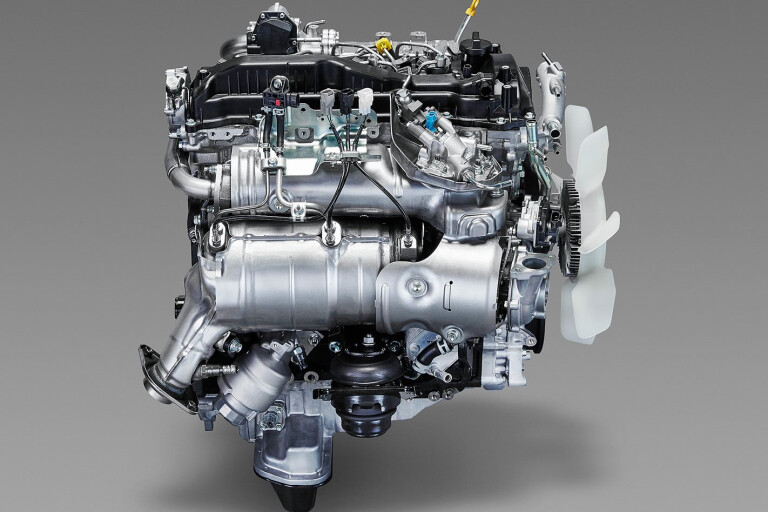
Toyota’s new GD-Series engines will hit Australian shores in the updated Prado and the new generation HiLux later this year.
The D-4D turbodiesel is the first of the series, with new design and technology set to achieve higher fuel efficiency, lower emissions and quieter operation.
According to Toyota, the engine (1GD-FTV) is the first in the world with Thermo Swing Wall Insulation Technology, making it one of the most thermally efficient on the market, with a thermal efficiency rating of 44 per cent.
Although it is smaller than the 3.0-litre engine it is replacing, it is said to offer 25 per cent more torque.
There is also 11 per cent more torque available at low revs and a 15 per cent improvement in fuel economy.
Toyota Australia Product Public Relations Manager Steve Coughlan said the GD-Series will be offered in Australia later this year – first, in the updated Prado and then later with the new generation HiLux.
The Prado will be available with the new 1GD-FTV 2.8L and the New Generation Hilux will be available with both the 1GD-FTV (2.8L) and, for the first time in Australia, a smaller capacity 2.4L (2GD-FTV).
“These new engines have been developed from the ground up and will be offered in a broad array of markets around the world,” Coughlan said.
“With many regions having different regulatory and emissions requirements, engine configurations vary based on local conditions.”
The Australian engines will offer compliance to Euro 5 emissions standards and include a Diesel Particulate Filter (DPF) to provide lower emissions.
There are no immediate plans to offer the urea-based (selective catalytic reduction) SCR technology.
Engine technical specifications
|
| 1GD-FTV | 2GD-FTV |
| Displacement (cc) | 2,754 | 2,393 |
| Bore x stroke (mm) | 92.0 x 103.6 | 92.0 x 90.0 |
| Compression ratio | 15.6:1 | 15.6:1 |
| Max. power (kW @ rpm) | 130 @ 3,400 | 110 @ 1,200 |
| Max. torque (Nm @ rpm) | 450 @ 1,600 – 2,400 | 330 @ 1,600 – 2,000 |
| Low-speed torque (Nm @ rpm) | 370Nm @ 1,200 | 330 Nm @ 1,200 |
Exact specifications may vary according to national market.
New engine features
According to Toyota, the new engines have shown high thermal efficiency, quiet operation and powerful performance in extremely hot and cold environments and at high altitudes above 4,500 metres.
Toyota has made the engine catalyst 30 per cent smaller and has reduced the number of exhaust layouts from 18 to just three, simplifying the engines’ deployment worldwide and reducing the environmental impact.
Next generation advanced thermal insulation diesel combustion
The new engine's performance has been largely credited to the application of Thermo Swing Wall Insulation Technology, and to a SiRPA (a silica-reinforced porous, anodised aluminium coating) on the pistons. This reduces the cooling loss during combustion by about 30 per cent. SiRPA’s high insulation and dissipation qualities make it easy to heat and to cool.
The air intake port has been shaped to allow a significant increase in the amount of airflow into the cylinders; the piston combustion chamber shape has been revised; and the common rail fuel injection system allows for more advanced pressure control and injection optimisation. Air consumption is maximised, which enables high thermal efficiency and low emissions to be achieved.
Precise pilot injection, matching the state of the ambient air, takes place ahead of the main injection to shorten ignition delay. This means stable combustion is achieved, even in harsh environments, together with quiet running and high thermal efficiency.
Compact, high-efficiency variable geometry turbocharger
The GD engines use a new turbocharger that is 30 per cent smaller than its predecessor. Produced in-house by Toyota, it has a new turbine that improves efficiency and a new impeller that gives instantaneous throttle response and allows maximum torque to be obtained over wide engine rev range.
Toyota-first urea selective catalyst reduction system
Using Toyota’s proprietary, compact, high-dispersion urea selective catalyst reduction system eliminates up to 99 per cent of NOx emissions, one of the principal causes of air pollution. This helps the engine conform to Euro 6 and other international emissions standards.
Production and markets
The current KD family of engines will be phased out gradually and replaced with the new GD units, By 2016, production will reach about 700,000 units a year, available in around 90 world markets. Toyota aims to increase this number to at least 150 by 2020.
Get the latest info on all things 4X4 Australia by signing up to our newsletter.

COMMENTS